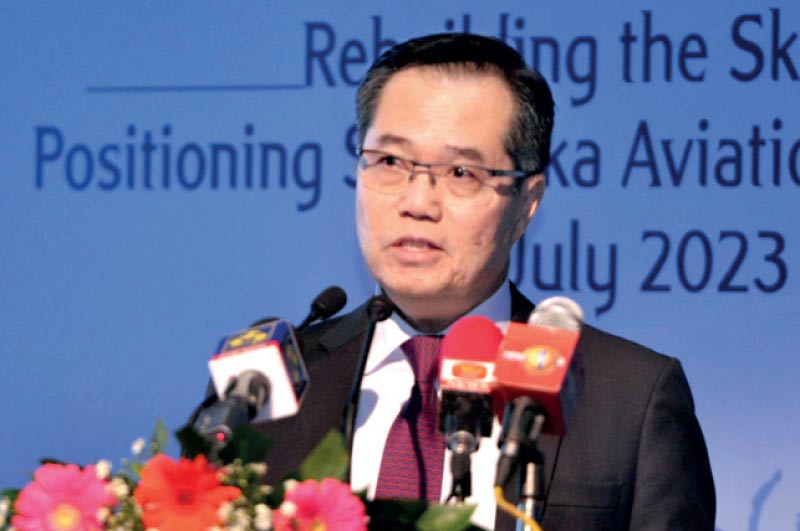Tuesday Apr 08, 2025
Tuesday Apr 08, 2025
Monday, 17 July 2023 03:55 - - {{hitsCtrl.values.hits}}

IATA Regional Vice President Philip Goh - Pic by Lasantha Kumara
By Charumini de Silva
The International Air Transport Association (IATA) on Friday called on Sri Lanka to take steps towards creating an aviation blueprint that can lead to greater economic growth and prosperity through the development of a robust aviation industry.
“As the industry emerges from the ashes post-COVID pandemic, we believe that aviation and connectivity play an even bigger role in Sri Lanka’s economic development and social progression and advancement. But none of this will happen by chance, thus we urge the Government and all industry stakeholders to collaborate on developing a blueprint to support and to shape the growth and the development of Sri Lanka’s aviation industry,” IATA Asia Pacific Regional Vice President Philip Goh said.
Delivering the keynote address at the first Aviation Day in the Asia and the Pacific Region post-pandemic in association with the Civil Aviation Authority of Sri Lanka yesterday Goh highlighted three key areas to consider in the aviation blueprint: facilitating sustainable growth, ensuring safety, and promoting sustainability.
In terms of facilitating sustainable growth, Goh stressed the importance of an updated airport master plan as the first step. He urged the Government to engage in a consultative approach that involves airlines to ensure industry input is considered.
Goh also mentioned the ongoing efforts to expand the Bandaranaike International Airport, applauding the Government for its dedication. He further emphasised the significance of including industry stakeholders in the master plan, citing it as a global best practice.
Regarding safety, the IATA Regional Vice President highlighted the importance of sustainable growth in a safe manner. IATA plans to support Sri Lanka’s aviation industry by conducting safety-related training in August for CAASL and Sri Lankan Airlines, utilising the International Airlines Training Fund. Goh also suggested exploring the use of the IATA Operational Safety Audit (IOSA) and IATA Safety Audit for Ground Operations (ISAGO) to enhance aviation safety in Sri Lanka.
In terms of sustainability, Goh commended Sri Lanka’s policy goal of achieving net-zero carbon emissions from aviation by 2050.
He expressed satisfaction with the country’s focus on ensuring the availability of sustainable aviation fuels (SAF). Sustainable aviation fuels have the potential to reduce more than 60% of aviation carbon emissions by 2050. Goh encouraged the Government to adopt a comprehensive consultation process involving airlines and other stakeholders to develop sustainable aviation policies.
Goh also emphasised the need for Sri Lanka to digitise passenger and cargo processes to address capacity constraints, increase efficiency, and enhance the travel experience. He acknowledged that many of the current processes in Sri Lanka are paper-based and suggested leveraging IATA’s One ID and One Record initiatives to support digitisation efforts.
Updating on the global scenario of the aviation industry post-pandemic, he said that between the years 2020 and 2022, the global airline industry recorded massive losses totalling some $ 180 billion and airlines in the Asia Pacific region accounted for the largest share of 40% or over $ 70 billion.
“Those are very sobering numbers for the industry. Fast forward three years and the good news is that a strong recovery is taking place and is underway,” he added.
IATA Regional Vice President said as of the end of May, total global passenger traffic has already recovered and reached 96% of 2019 levels led especially by domestic traffic recovery, which has already exceeded three pandemic levels.
However, he said the international track has lacked domestic recovery but still sees encouraging recovery as the global level has reached 90% of May, compared to 2019 levels.
“The reopening of international borders in the Asia Pacific region has been slower compared to other major regions worldwide, hampering the recovery of the aviation industry. As of May this year, international traffic in the region reached only 69% of pre-pandemic levels, while travel figures in North America and the Middle East have already surpassed pre-COVID numbers. Despite the slower pace, there are positive signs of progress, with the global airline industry expected to record a cumulative profit of $ 9.8 billion this year,” he explained.
However, Goh said carriers based in the Asia Pacific region, including Sri Lanka, are still anticipated to report a collective loss of approximately $ 7 billion.
“The effects of the pandemic have impacted the aviation sector in Sri Lanka as well. By April, passenger numbers had already reached 71% of 2019 levels, indicating a positive trajectory. Although, not yet fully back to normal, the sector is moving in the right direction.
The development of an aviation blueprint aligns with Sri Lanka’s aspirations for economic growth, job creation, and increased GDP contribution. The aviation sector, which previously supported 700,000 jobs and contributed approximately 9% to the GDP, has the potential to exceed a million jobs and contribute nearly $ 30 billion to the country’s GDP by 2038, according to a study conducted by IATA in 2018/2019.